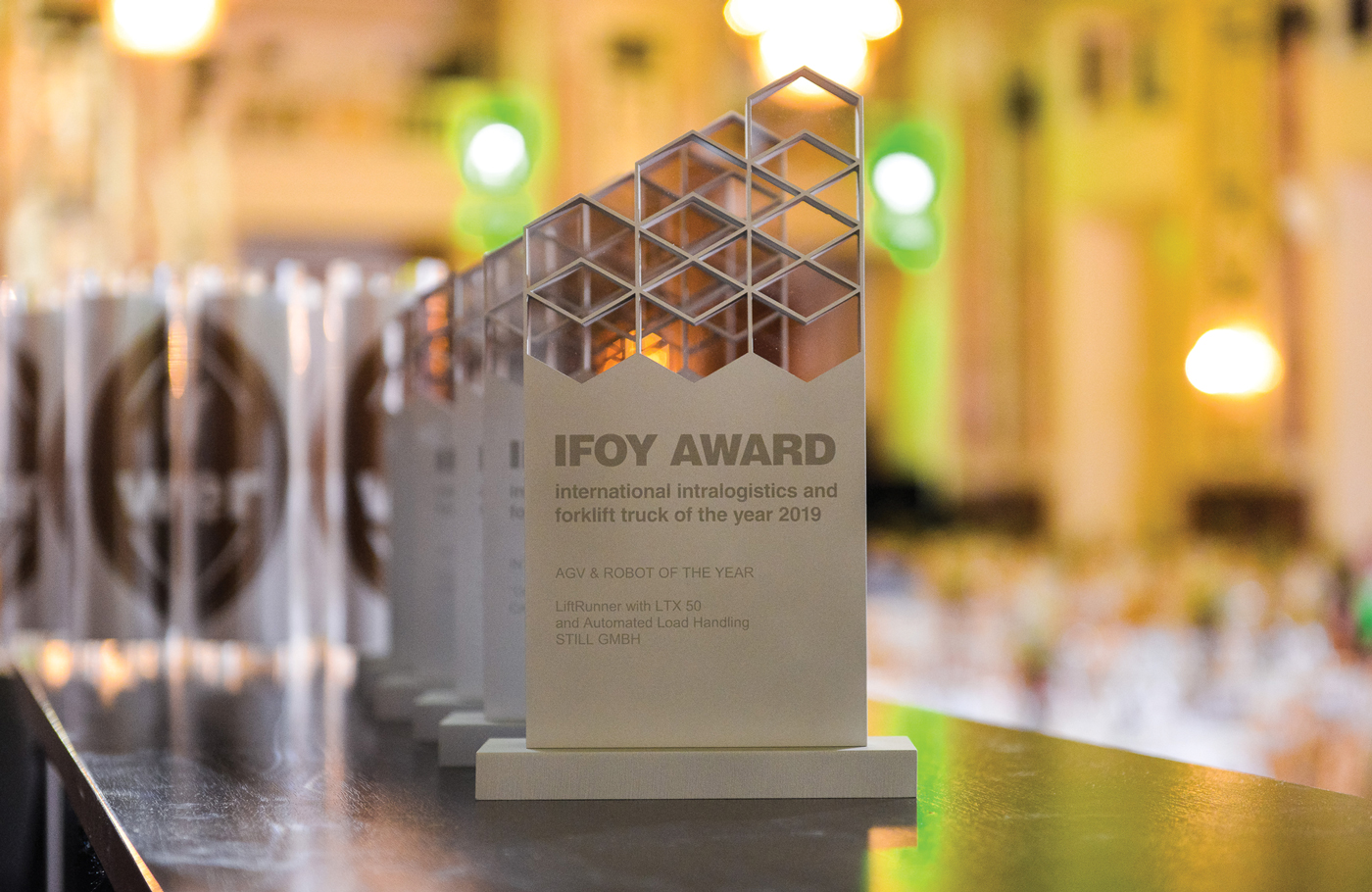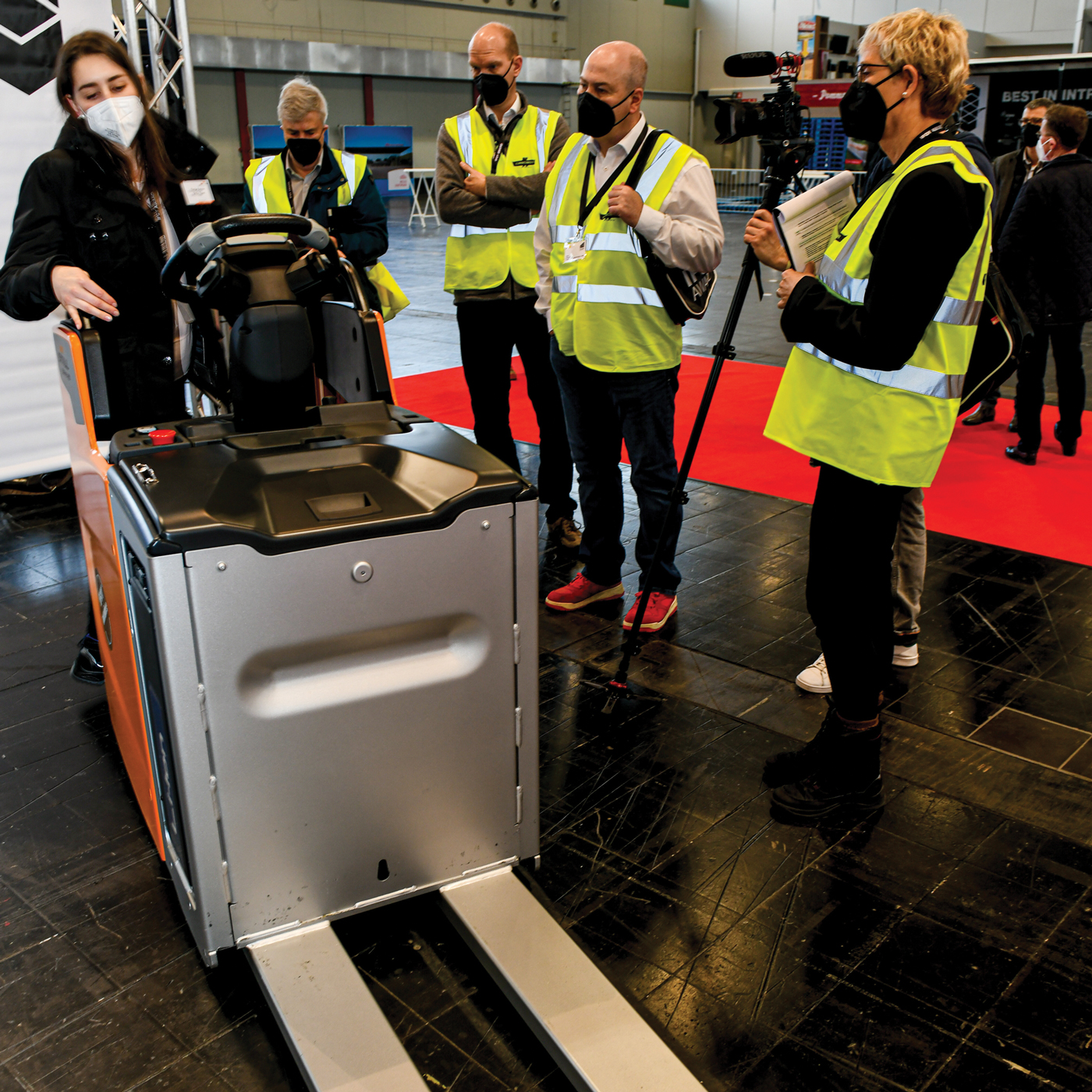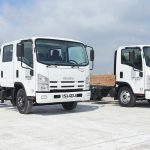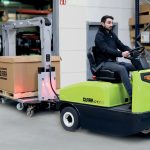Acing the acid test: who are the winners?
Acing the acid test: who are the winners?
The world’s largest and toughest intralogistics test has come to an end. At the IFOY Test Days in Dortmund, 17 nominees for the International Intralogistics and Forklift Truck of the Year (IFOY) Award underwent five days (March 22 to 26) of multi-stage testing. Never before have so many products and solutions been in the final for the “Oscars of intralogistics”.
The finalists included automated guided vehicles (AGVs), robots, specialised vehicles, and software and complex warehouse solutions. The companies Arculus, Cargotec Engineering, HAI Robotics, Hänel, H+E Produktentwicklung, HHLA Sky, the BMW subsidiary IDEALworks, Interroll Group, NIMMSTA, OPPIDUM TIC, STILL, SYNAOS, VOLUME Lagersysteme and WAKU Robotics were all present in the 8 400 m2 test arena, eager to win a trophy.
The IFOY Audit 2021, the ninth round of the competition, was held for the first time at the premises of new IFOY partner Messe Dortmund. It consisted of various tests by almost 100 logistics experts from industry, trade and logistics services.
The assessment criteria included innovation value, technology, ergonomics and handling, safety, marketability, design and customer benefits, as well as cost-effectiveness and sustainability. Importantly, the nominees in a category were not compared with one another, but instead with currently comparable products and solutions on the market. This ensured that the performance values and the innovation gap could be assessed objectively.
“Only those who outperform their direct competitors in terms of innovation have a chance of winning,” said executive jury chairwoman Anita Würmser.
The first stage in the three-phase IFOY audit was the practice-oriented IFOY test, overseen by Dutch intralogistics expert Theo Egberts, who compared the finalists with the relevant solutions and equipment in the competition. The industrial trucks went through standardised driving and functional tests, including the IFOY test protocol, which comprised more than 80 criteria, taking into account factors such as sustainability, economy, safety and ergonomics.
In the second stage, researchers conducted the IFOY Innovation Check. Scientists from the Fraunhofer Institute of Material Flow and Logistics and the Technical Universities of Munich and Dresden assessed the nominees in terms of market relevance, customer benefits, type of execution and degree of innovation.
The test culminated in the assessment by the 26 jurors and their approved advisors. The jury members – trade journalists from all continents, including our very own editorial director Charleen Clarke – were presented with all the results of the IFOY test as well as the IFOY Innovation Check. Here are the finalists at a glance:
Arculus
The German software and robotics expert Arculus, from Ingolstadt, made it to the finals with two products and solutions: the multi-vendor fleet management system Arculus Fleet, and the AGV Arculee2.
With Arculus Fleet, Arculus presented a manufacturer-independent fleet management system for AGVs via the new VDA 5050 interface. The system makes it possible to use autonomous vehicles from different suppliers in the same space, regardless of the navigation technology, the kinematic properties and the dimensions of the AGVs.
The jury’s verdict was that the standardised interface opens up possibilities for the mixed operation of automated warehouse vehicles – something unthinkable until recently: “The fact that Arculus Fleet is brand-independent facilitates the selection of the most suitable AGV for a specific transport requirement. Since the system takes into account the current traffic situation on site for dynamic routings, even higher efficiency and availability can be possible.”
The company is also hoping to win an IFOY Award for its nominated AGV Arculee2. Developed for in-house production and logistics environments, the autonomous mobile robot (AMR) with a capacity of up to one tonne is designed to bring autonomous driving and the economies of mass production to industrial areas. The AGV is controlled by a robotic unit that enables over-the-air updates and fleet learning.
“It is a proper industrial product and looks robust,” explains Clarke. “It is also very easy to charge.”
As the variety of products in AMRs grows, the differentiator is not so much the hardware as the software. Easy implementation and integration as well as management and possible changes are in demand, according to the test verdict. “In this area, the Arculee2 performs above average compared to the competition. It is extremely robust, extremely compact and, thanks to the flexible customisation and update options, also future-proof.”
MOFFETT E4-25.3NX
Cargotec Engineering Ireland secured a place in the final with the second generation of its MOFFETT E4-25.3NX, the world’s first all-electric truck-mounted forklift. In addition to numerous safety features, the 2,5 t capacity truck has a fully electric three-wheel drive and is emission-free.
“I like the fact that it’s not much heavier than the diesel truck and also that it is so easy to drive,” says Clarke. “The cost savings over a diesel truck are the cherry on top. I’m also impressed at the lack of noise, which is very beneficial to the driver (no special hearing protection is needed) and of course to other people in the area. This also allows it to be driven at night. I also really like the fact that the low-vibration electronic drive increases driving comfort and reduces fatigue and health risks for the driver.”
This ties in with the IFOY test verdict, which found that Cargotec offers an excellent alternative to the diesel-powered truck-mounted forklift, both ecologically and economically. “The forklift truck is quiet, powerful and smooth. The E4-25.3NX has a modern design and offers the operator a spacious workplace. The safety equipment is of a high standard. The ability to operate in both semi-open and enclosed environments greatly expands the possibilities of this truck.”
MSC Technologies
Intralogistics provider Hänel reached the final round with a warehouse solution. It implemented the integration of 12 Hänel Rotomat warehouse lifts over two floors for MSC Technologies, a provider of embedded systems. The carousels not only connect the physical flow of goods, but are also seamlessly integrated into the SAP environment. A unique feature is that the lift control is also a SAP terminal.


HUSKi
The HUSKi tugger train solution, from H+E Produktentwicklung, can transfer goods weighing up to 1,5 t contactless, automatically and autonomously, making autonomous intralogistics possible in the large goods sector.
The IFOY test verdict highlighted that it is no longer possible to imagine intralogistics without tugger trains. “However, the capacity of existing systems is often limited. HUSKi offers a solution to move weights of over 500 to 1 500 kg without the help of manipulators,” the experts explained. “The integrated intelligence and the associated communication with process machines are unique.” A more intuitive operation of the display would, however, be desirable, they agreed.
HHLA Sky Integrated Drone Control Centre
HHLA Sky claims to be the first provider with a professional, globally scalable end-to-end drone system. The drone management system organises all processes in the operation of drones and remote-controlled vehicles on a single platform. It is able to fly more than 100 drones simultaneously and even out of sight. “You can use it for robots, AGVs and almost anything,” Clarke points out.
“I think the open interface (VDA 5050) for the integration of AGVs/AMRs from different manufacturers is impressive. This is very practical, because the customer can operate AGVs/AMRs from different manufacturers in the same area. As the company rightly points out, it offers one solution for multiple fleets from different suppliers in the same space: there’s one system to train, one system to maintain and a flexible licensing model. This really makes sense.”
With the help of the Drone Control Centre, complete process chains can be mapped automatically and quickly. When sites are physically separated by roads, railways, rivers or lakes, the system shortens transport routes and reduces the time required to a minimum.
Documents, keys, material and liquid samples or papers for the clearance of ships and freight transports are thus reliably and quickly brought to their destination. For surveillance tasks or technical inspections, the universal drone platform can be equipped with cameras, sensors or loudspeakers.
“Drone use in logistics is still in its infancy, but is one of the fastest-growing market segments of all,” was the verdict. “With the Integrated Drone Control Centre, HHLA Sky already offers a professional system with all the necessary functions for the automatic and simultaneous flight of a large number of drones over long distances and out of sight. HHLA Sky Integrated Drone Control Centre thus sets a new standard for the professional industrial use of drones. The unique solution significantly increases the efficiency of drone operations.”
HAI Robotics
HAI Robotics from Shenzhen, China, was represented twice in the final round. The first was the new HAIPICK A42T, a telescopic lift autonomous case-handling robot. It enables “goods-to-person” order-picking and covers a height of up to 6,5 m with its telescopic lift function.
Also nominated was a warehouse solution based on the HAIPICK A42N model – an autonomous carton-picking robot to enable mixed picking of cartons and totes of different sizes. The manufacturer adopts 3D visual recognition technology to enable the machine to locate and directly access totes and cartons without the need for codes.
Iw.hub
The fully autonomous, mobile robot iw.hub, from BMW subsidiary IDEALworks, is not only offered in an attractive price segment, but with its cloud-based control platform, AnyFleet, it can be implemented within two days without any structural adjustments and, based on the VDA 5050 standard, also with third-party devices. According to the manufacturer, the innovative solution is up to 50% cheaper than existing solutions on the market while offering the same functionalities, and is also successfully in use at parent company BMW.
The AMR measures 641×1440 mm (width x length) and has a minimum underride height of 22 cm. In mixed traffic – with other, manually operated and/or autonomous vehicles – the iw.hub reaches a speed of about 2,2 m/s (just under 8 km/h). This makes the iw.hub one of the faster AMRs. The maximum payload is 1 000 kg.
“It blends affordability with innovation and, while it is robust, it is also a good-looking robot,” says Clarke. “This will probably mean that it will be better treated in day-to-day operations. I like the fact that intermediate charging is possible via any standard 220 V socket. This is practical and also keeps costs down.”
The experts emphasised that behind the robot is an innovative control concept with high flexibility. “The performance is impressive, especially when it comes to picking up badly positioned loads; so is its speed.”
Smart Pallet Mover (SPM)
The SPM from the Interroll Group is a new, mobile robotics solution for the automation of pallet transport in the areas of production machines and order-picking, with the ability to transport pallets or boxes weighing up to 1 000 kg.
Its simple, modular mechanical design is based on a novel concept that separates the “carrying” and “drive” functions. It consists of four main components: a non-driven roller conveyor section, a battery-powered unit on rails, a transfer and an intuitive online tool for programming the system and connecting it to other machines. The mobile, autonomous conveyor system is flexible and scalable and can be used, for example, as an efficient extension of static roller conveyors.
“It boasts a compact design, good safety, a quiet and cost-effective operation, simple installation and – most importantly – it truly is a new system,” Clarke explains.
STILL
A well-known participant at the IFOY Award is the Hamburg-based intralogistics provider STILL. It has been awarded several trophies in recent years. This year, the EXH-S 25 was nominated – a low-lift pallet truck with a load capacity of 2,5 t for particularly tough and narrow work areas.
It is characterised by its compact dimensions and can travel at speeds of up to 14 km/h. A second nomination goes to STILL for a warehouse solution.
As part of its Danfoss Project, the company supplied a fully coordinated combination of three automated series industrial trucks each for the new production warehouse of Danfoss Power Electronics in Tinglev, Denmark, and installed all system components.
“STILL offers a high level of automation, which is super-impressive,” Clarke reports. “Also, the cost savings of about 20% are truly meaningful. It is a sign of things to come, since it shows how automated warehouses will be controlled, monitored and analysed in the future.”
The jury also approved of STILL’s capability to enable the storage of movement and operating data of the entire system for subsequent analysis.

An array of start-ups
The jury nominated five start-ups in the “Start-up of the Year” category. NIMMSTA is competing with the HS 50, the first backhand scanner with a touch display that enables hands-free scanning.
The LOGISTICS INTERCHAT platform from OPPIDUM TIC in Zaragoza, Spain, is designed to solve communication problems for freight forwarders with employees in loading and unloading centres. It also facilitates compliance with social-distancing regulations.
SYNA.OS Logistics from the Hannover-based start-up SYNAOS offers a software solution for coordinating factories and logistics centres using artificial intelligence and cloud technologies. It optimises intralogistics processes and routes, and controls autonomous mobile robots, among other features.
“SYNA.OS Logistics offers a solution for the integration of different industrial trucks from different manufacturers in one piece of software, which has access to all available information and optimises control,” the jurynoted. “Software for data integration is already known. Syna.OS goes one step further by also taking over the control.”
The fourth candidate in the start-up category is the Volume WAVE from VOLUME Lagersysteme. This product is the world’s first ultra-compact, fully automated pallet shuttle warehouse with individual access to storage areas, and offers an alternative to automated storage and retrieval stacker crane systems as well as wide and narrow aisle warehouses.
“Scoring highly in the important areas of novelty and functionality, Volume WAVE impresses because of the space savings (it requires 40% less space compared with conventional storage technologies with the same performance), its flexibility and the fact that it is scalable,” notes Clarke.
The fifth finalist is the WAKU Robotics solution WAKU Sense. This is a real-time analytics dashboard, which can be used to benchmark the different robot types in performance, the capacity of utilisation and reliability across sites.
“WAKU Sense is a solution for integrating the data of various industrial trucks from different manufacturers in a cloud-based platform,” the experts agreed. “The user receives all available information directly from the vehicles without access from the respective control system. This gives the user an uninfluenced overview of the status and data of the various vehicles at the working level.”
Neither the participants of Intralogistics Test Camp nor the nominees have yet heard who has won an IFOY Award. For that, they’ll have to wait until The IFOY Award Night.
Watch this space to see who The Oscar goes to ….
Published by
Focus on Transport
focusmagsa




